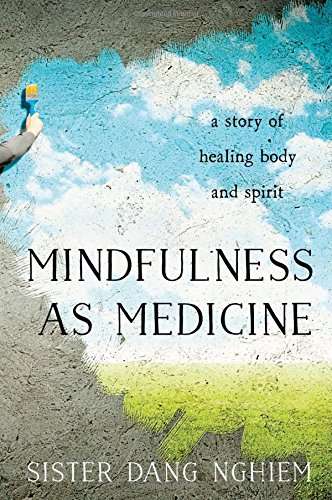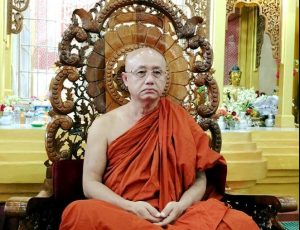
After she was diagnosed with Lyme disease, Sister Dang Nghiem began to experience debilitating symptoms: fatigue, neurological pain, cognitive impairment. As a trained physician, she recognized the bacterial infection, often transmitted by ticks, as a serious problem. As a Buddhist nun in the tradition of the Zen master Thich Nhat Hanh, she embraced the illness over time as an opportunity to transform her practice.
In Mindfulness as Medicine (Parallax Press 2015), Sister Dang Nghiem details her thoughts on healing. Her experiences with illness form the backbone of the book, including her struggles with hypertension, neuro-Lyme disease, diabetes, and the traumas of an abusive childhood. But she goes beyond personal experience to give patient, insightful advice about how a Buddhist mindfulness practice can lead to greater self-awareness and healing for body and mind.
The book takes its structure from the Four Immeasurables, which her teacher, the Ven. Thich Nhat Hanh, has translated as interbeing, friendship, compassion, and joy. To these, he has added the qualities of trust and reverence. In each section of the book, Sister Dang Nghiem (often referred to as Sister D) broadly takes the theme of each Immeasurable, relating it to overcoming both acute and chronic traumas. She wanders from personal anecdote to broader insights about the nature of each Immeasurable, to concrete mantras and practices, including guided meditations. Despite the rather loose structure, the chapters hold together because they always come back to healing as a guiding principle.
Reading the blurb on the back cover, a casual reader could be forgiven for thinking that the book is mostly about physical healing. Lyme disease features prominently in the marketing material, as well as mentions of the author’s training as a doctor. In fact, Sister D takes a much broader look at healing, examining the myriad connections between emotional life and Buddhist practice and their manifestations in physical form.
In Buddhist literature, the focus is often on the mind. Many practices require the body to sit still while the mind engages in focused meditation practice. For Sister Dang Nghiem, the body is equally essential. She once asked her teacher, whom she affectionately calls Thay, for calligraphy that stated, “True love begins with the body.” She recalls looking into her teacher’s “sometimes stern face” as he questioned whether she was creating a false duality between body and mind. But for Sister Dang Nghiem, the body matters. “That’s what I have been practicing since I got sick,” she told her teacher, and he obliged her.
This practice of dwelling mindfully within the body means embracing the uncomfortable and finding joy in the mundane. She relates the meditative practice of Touching the Earth, in which she scans each part of her body: “Breathing in, I am aware of my forehead. Breathing out, I relax the vertical and horizontal lines on my forehead with a smile,” she relates. But it’s not just awareness; a spontaneous happiness arises from being in touch with the physical form. “Breathing in, I am aware of my teeth,” she continues. “Breathing out, I smile to this non-toothache moment!” This kind of loving address to the physical form helps to avoid malaise about how the body functions. Such mindfulness practices can locate deep-rooted emotional and mental hurts that will affect the body later. They also cultivate joy and gratitude for health. “It may seem strange at first to communicate with your body, but your body is a living organism and it is always communicating with you!” she writes. She even begins to feel some affection for the tick that infected her with Lyme disease, seeing in it an essential Buddha-nature. She draws a picture of the tick and daily asks it, “Help me to live in harmony with you” as part of her path to healing.
It isn’t always the body that causes sickness; sometimes traumas of the past manifest in physical form. “With our awareness that the body’s pain and suffering is rooted in the mind, we need to pay attention to the pain instead of simply numbing it with medication or using entertainment to forget it,” she writes. Much of the book plays with this intimate, intricate relationship between mental and physical health. As a strong meditation practice helps get to the root of aches in the body, so physical health paves the way for better mental well-being, she asserts. The two are essentially, inextricably linked.
Sister Dang Nghiem makes no claims that mindfulness practice will miraculously cure illness. She still struggles with Lyme disease and other medical issues. What she can control are the mental symptoms that accompany the physical illness—the Buddha’s famous “second arrow” of suffering. Pain cannot always be relieved, she reminds us; but suffering can. Sickness and death are natural parts of existence, and therefore cultivating calm, rather than fear, in their presence is the best way to maintain equanimity.

Much of what she comes back to is building a relationship with oneself. She recalls in a letter to her brother a dream about a great palace, stinking of urine and mopped diligently by formally dressed visitors. “Slowly it came to me that the incredibly ancient, magnificent, and imposing room is my body,” she writes. “The many people working to maintain the place are the buddhas, bodhisattvas, people, animals, plants, and minerals that help uphold and sustain my life all of these years.” Her realization of the preciousness of her own form helps her recommit to care for herself. Her connectedness to the ancestors that helped bring her body into being, including her own mother, gives her a great reverence for all life.
Relationships can be a great source of suffering—and therefore a great opportunity for healing. Sister Dang Nghiem spends the most time on sibling, parent, and romantic relationships, although she also touches on relationships within the monastic community as well. Some of the best anecdotes in the book concern her mother, who suffered much pain in her lifetime and died at the age of 36. Sister Dang Nghiem recalls walking on her mother’s back as a child to help relieve her spinal pain. She hated it, wanting only to go play. Now, however, she realizes that she walks every day on the back of Mother Earth. Her commitment to recognizing the natural world and caring for it comes as an extension of her love for her own biological mother. “It’s never too late to connect with her and heal her,” she recalls, finding a way to reconnect with the loss of a parent through walking meditation, hiking, and an appreciation of nature.
Mindfulness as Medicine sometimes feels as if it could have benefitted from tighter editing and a more focused message, but the overall theme of health is useful and not often discussed in Buddhist literature. It’s also relevant to the modern practitioner, who brings a sometimes achy, hurting body to the cushion to practice. Through the ongoing process of healing, Sister Dang Nghiem reminds us: “We continue to be there for ourselves no matter what.”
Related features from Buddhistdoor Global
Film Review: Walk with Me – A Welcome Break from Stressful City Life
Spiritual Bypassing and the Dangers of Unresolved Emotional Wounds
Driving at Night












